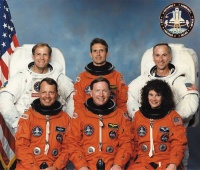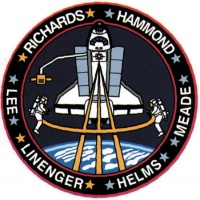STS-64
From The Space Library
 | |
| Organization | NASA-Office of Space Flight (United States) |
|---|---|
| Mission type | Human Crew |
| Launch date | September 9, 1994 |
| Launch vehicle | Space Shuttle |
| Launch site | Cape Canaveral, United States |
| COSPAR ID | 1994-059A |
| Inclination | 57 degrees |
| Experiments | Here |
| Alternate Names | 23251 |
| Additional Information | Here |
| Data Collection | Here |
| Payload Mass Up | 9260 kg |
| Payload Mass Down | 9261.36 kg |
| Orbiter | Discovery |
| Lift Off Mass | 2,047,342.73 kg |
| Orbiter Weight at Liftoff | 110,349.09 kg |
| Orbiter Weight at Landing | 96,389.09 kg |
| Landed | Concrete runway 04 at Edwards Air Force Base, Calif. |
| Orbits of Earth | 177 |
| Orbital Altitude | 140 nautical miles (161 statute miles) |
Contents |
[edit] Crew
- Commander: Richard N. Richards
- Pilot: L. Blaine Hammond Jr.
- Payload Commander:
- Mission Specialist 1: Carl J. Meade
- Mission Specialist 2: Mark C. Lee
- Mission Specialist 3: Susan J. Helms
- Mission Specialist 4: Jerry M. Linenger
- Mission Specialist 5:
- Payload Specialist 1:
- Payload Specialist 2:
ISS/Mir Crew Transport
[edit] Mission
STS 64, a US Shuttle mission, was launched from Cape Canaveral. A major payload on board was the Spartan sub-satellite that was released from the shuttle on September 13. Also on board were 12 Get-Away Special (GAS) experiments designed and built by high school and university students, and Orbit Stability Experiment (OSE), and a Robot Operated Materials Processing System (ROMPS). STS 64 marked the first flight of the Lidar In-space Technology Experiment (LITE) and the first untethered U.S. extravehicular activity (EVA) in 10 years. The LITE payload employed lidar, which stands for light detection and ranging, a type of optical radar using laser pulses instead of radio waves to study Earth's atmosphere. The first spaceflight of lidar was a highly successful technology test. The LITE instrument operated for 53 hours, yielding more than 43 hours of high-rate data. Unprecedented views were obtained of cloud structures, storm systems, dust clouds, pollutants, forest burning and surface reflectance. Sites studied included the atmosphere above northern Europe, Indonesia and the south Pacific, Russia and Africa. Sixty-five groups from 20 countries were making validation measurements with ground-based and aircraft instruments to verify LITE data. The LITE science program is part of NASA's Mission to Planet Earth. Mission Specialists Lee and Meade completed the 28th EVA of the Space Shuttle program on Sept. 16. During a six-hour, 15- minute EVA, they tested a new backpack called Simplified Aid for EVA Rescue (SAFER), designed for use in the event a crew member becomes untethered while conducting an EVA. On the fifth day of the mission, the Shuttle Pointed Autonomous Research Tool for Astronomy-201 (SPARTAN-201) free flyer was released using the Remote Manipulator System arm. Making its second flight on a Shuttle, SPARTAN-201 was designed to collect data about acceleration and velocity of solar wind and to measure aspects of the sun's corona. Data were recorded for playback after return to Earth. SPARTAN-201 was retrieved after two days of data collection. Other cargo bay payloads included: the Shuttle Plume Impingement Flight Experiment (SPIFEX), a 33-foot (10-meter) long instrumented extension for the Shuttle robot arm. SPIFEX was designed to collect data about orbiter the Reaction Control System (RCS) thrusters to aid understanding about potential effects of thruster plumes on large space structures, such as the Mir space station or planned international space station. Robot Operated Processing System (ROMPS) was the first U.S. robotics system operated in space, was mounted in two Get Away Special (GAS) canisters attached to the cargo bay wall. A GAS bridge assembly in the cargo bay carried 12 cans, 10 holding self-contained experiments. The Middeck experiments included: Biological Research in Canister (BRIC) experiment to investigate effects of spaceflight on plant specimens; Military Application of Ship Tracks (MAST) to take high-resolution imagery of ship tracks and to analyze wake formation and dissipations; Solid Surface Combustion Experiment (SSCE) to supply information on flame propagation over fuels in space; Radiation Monitoring Equipment III (RME III) to measure ionizing radiation; Shuttle Amateur Radio Experiment II (SAREX II) to demonstrate feasibility of short-wave radio contacts between the orbiter and ground-based amateur radio operators; and the Air Force Maui Optical Station (AMOS) test, which required no onboard hardware.
[edit] EVA
Extravehicular Activity (EVA) conducted by Mark C. Lee and Carl J. Meade, 6 hours, 51 minutes. Lee and Meade tested the Simplified Aid for EVA Rescue (SAFER), a small, self-contained propulsive backpack device that provides free-flying mobility for an EVA astronaut in an emergency. They also evaluated several tools and an electronic cuff checklist that allows crew members greater and easier access to information away from the spacecraft.
[edit] Payload
Lidar In-Space Technology Experiment (LITE); Shuttle Pointed Autonomous Research Tool for Astronomy (SPARTAN) 201-II; Robot-Operated Materials Processing System (ROMPS); Shuttle Plume Impingement Flight Experiment (SPIFEX); getaway special (GAS) bridge assembly with 10 GAS experiments; Trajectory Control Sensor (TCS); Simplified Aid for EVA Rescue (SAFER); Solid Surface Combustion Experiment (SSCE); Biological Research in Canisters (BRIC) III; Radiation Monitoring Experiment (RME) III; Military Applications of Ship Tracks (MAST); Shuttle Amateur Radio Experiment (SAREX) II; Air Force Maui Optical Site (AMOS) Calibration Test
[edit] Books about the Space Shuttle Program
Buy This Book Click here |
Buy This Book here |
Buy This Book Click here |
Buy This Book Click here |





